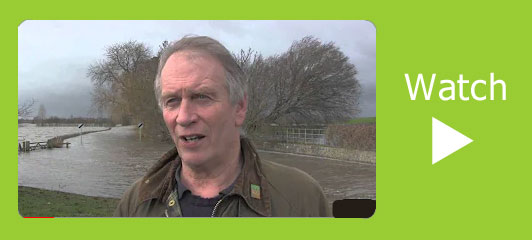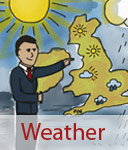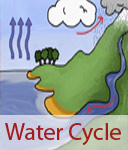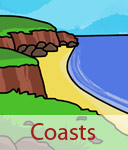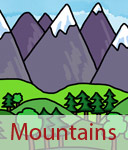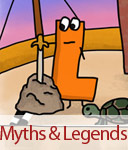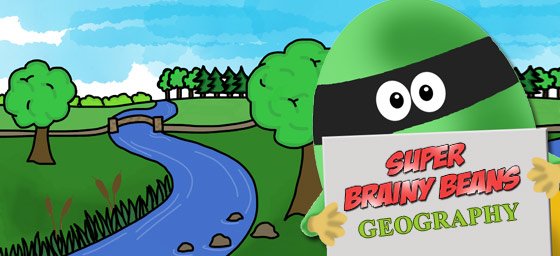
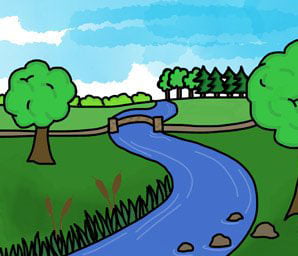
Rivers and floods
Rivers and floods for kids KS2 learning at Primary School. Primary Homework help with rivers and floods. Facts about rivers, and information about floods and why they happen.
What are the features of a river?
Rivers are amazing natural waterways that shape the land and provide life for plants, animals, and people. Let’s look at some of their key features:
Water flow
A river is a natural waterway that is always on the move. It flows from one place to another, like a long, winding road made of water. Just as roads let cars travel, rivers are the “roads” that water follows across the land.
Source
Every river has a starting point, called its source. This is usually found high up in mountains or hills, where water first appears. It could be a spring bubbling out of the ground, melting snow and ice from a glacier, or even rainwater collecting in a small stream. The source is like the river’s “birthplace.”
Channel
The river flows along a pathway called a channel. This is the route the water takes as it moves across the land. Channels can be wide and deep, or narrow and shallow, depending on where the river is.
Banks
The edges of the river are called its banks. These are like the walls or sides that guide the river along its journey. Banks can be steep and rocky or gently sloping with grass and trees.
Tributaries
As rivers travel, they are often joined by smaller streams or rivers called tributaries. These “helper streams” feed into the main river, giving it more water and helping it grow stronger.
Meanders
Rivers don’t usually flow in straight lines. Instead, they twist and turn, forming bends called meanders. From above, meanders make the river look like a snake slithering across the land. Sometimes, when meanders get cut off, they leave behind curved lakes called oxbow lakes.
Rapids and waterfalls
When rivers flow over steep or rocky areas, the water speeds up, creating rapids—fast-moving, frothy water. If the land suddenly drops, the river can tumble over the edge to form a waterfall. These are some of the most dramatic and beautiful river features!
Delta
At the end of its journey, a river may spread out into many smaller channels, forming a wide, triangular area called a delta before meeting the sea, lake, or ocean. Deltas are rich in soil and nutrients, making them excellent places for wildlife and farming.
The journey of a river
A river goes on an amazing journey from its source (where it begins) to its mouth (where it ends). Along the way, it changes in size, speed, and shape. We can think of this journey in three parts:
Upper course, the beginning
This is where the river starts, high up in the hills or mountains. The river here is small and flows very fast. It cuts through the land, making valleys, waterfalls, and rapids.
Middle course, the middle
As the river travels downhill, it becomes wider and slower. It starts to bend and curve, forming meanders. Tributaries join in, giving the river more water and strength.
Lower course, the end
By the time the river reaches flat land, it is wide and deep. It flows slowly and carries lots of sediment. Near its mouth, the river may split into many smaller channels and form a delta before meeting the sea, a lake, or an ocean.
How do rivers change over time?
Rivers are never still—they are always moving and reshaping the land around them. Over years, decades, and even thousands of years, a river can look very different from when it first began. Here are the main ways rivers change:
Erosion
Erosion happens when the flowing water slowly wears away the rocks and soil along the river’s banks and bottom (called the bed). It’s like the river is gently “scrubbing” the land as it moves. Over time, erosion can make the river wider, deeper, and longer. Erosion can also carve out valleys, cliffs, and gorges—some of the most stunning features in nature.
Sediment
As rivers erode rocks, they carry tiny pieces of sand, soil, and stones with them. These are called sediment. A river acts like a delivery truck, carrying sediment along its journey. When the river slows down, it often drops the sediment, creating sandbanks, islands, or beaches. Over many years, these deposits can build up and change the river’s path.
Floods
When heavy rain falls or snow melts quickly, rivers can overflow their banks and cause floods. Floods spread water across the surrounding land, leaving behind layers of fresh soil and sediment. This can make farmland very fertile but can also change the shape of the river by creating new channels or even cutting through land to find a shorter route.
Meanders and oxbow lakes
Rivers love to curve and bend—these bends are called meanders. Over time, erosion wears away the outer bank of a meander (where the water flows fastest), while sediment is deposited on the inner bank (where water moves slower). This makes the curve bigger and bigger. Eventually, the river may cut through the middle, leaving behind a separate, crescent-shaped lake called an oxbow lake.
Deltas
When a river reaches the sea or a large lake, it slows down and drops lots of sediment, creating a delta. Deltas are always changing—the river can make new channels, block old ones, or grow larger over time as more and more sediment builds up. Some deltas are so big they can be seen from space!
Human influence
People also change rivers. Dams are built to store water or make electricity, which slows the river and creates reservoirs (artificial lakes). Canals or river diversions are dug to make travel easier or to prevent flooding. While these changes can help people, they can also disturb natural habitats and change how rivers behave.
Plants & animals in UK rivers
Rivers in the UK are like special homes for many different kinds of plants and animals. Water plants provide a safe place for water creatures to live. Plants and flowers grow along the riverbanks and give insects and birds a cosy home.
UK rivers are home to many animals and fish. One fascinating fish found in UK rivers is the Atlantic Salmon. It's a special fish that can swim long distances and comes back to the same river where it was born to lay its eggs. There's also the Brown Trout, a fish that loves clean and fresh water. And have you heard of the European Eel? These slippery creatures travel far and wide to find the perfect place to breed and grow.
In the rivers, you might also spot some amazing amphibians like the Common Frog. They hop around near the water, especially during the breeding season when they lay their eggs. And keep an eye out for the Common Toad too! They come out at night and live near rivers, ponds, and other watery places.
Otters are fantastic swimmers and live in rivers, hunting for fish and playing in the water. And there's the Water Vole, a cute little creature that makes its home in the riverbanks, munching on plants and enjoying a swim now and then.
Rivers attract many birds too. The Kingfisher is a beautiful bird loves that rivers because it can find yummy fish to eat. And don't forget about the Grey Heron. You might see it standing very still near the water, waiting patiently to catch its fishy meal.
Rivers are like busy communities filled with different plants and animals. They provide homes, food, and a safe place to live. Exploring the rivers can be an exciting adventure where you can discover the wonders of nature!
Famous rivers of the world
Rivers are some of the most important features on Earth. They provide water, transport, food, and homes for people, animals, and plants. Here are five of the most famous rivers in the world:
The Nile River, Africa
- The longest river in the world, stretching about 6,650 km (4,130 miles) through northeastern Africa.
- It flows through 11 countries, including Egypt, Sudan, and Uganda.
- Ancient Egyptians built their civilisation along the Nile because it provided water for farming in the hot desert.
The Amazon River, South America
- The second-longest river (around 6,400 km / 4,000 miles).
- It carries more water than any other river—about one-fifth of all the freshwater flowing on Earth!
- The Amazon rainforest around it is home to jaguars, sloths, pink river dolphins, and thousands of plants and insects.
The Congo River, Africa
- The deepest river in the world, reaching 220 metres deep.
- It flows through the Congo rainforest, the second-largest rainforest in the world.
- Hippos, crocodiles, and unique fish live in its waters.
The Yangtze River, China
- The longest river in Asia, about 6,300 km (3,900 miles) long.
- Provides water, transport, and energy for millions of people in China.
- Famous for the Three Gorges Dam, one of the largest dams in the world.
The Mississippi River, North America
- The second-longest river in North America, about 3,766 km (2,340 miles) long.
- Flows through 10 U.S. states and has been called the “spine” of America.
- Important for trade, farming, and wildlife like catfish, eagles, and beavers.
How can we look after our rivers?
Rivers are home to plants, animals, and people, so keeping them clean and healthy is really important. Here are some simple ways we can all help look after our rivers:
Keep it clean
Never throw rubbish into rivers or along their banks. Litter can pollute the water and harm animals. Always use a bin, and if you spot litter nearby, you can help by picking it up (with an adult’s permission) and putting it in the bin. A clean river is a safe river!
Save water
The less water we waste, the more stays in rivers for wildlife. Turn off the tap while brushing your teeth, take shorter showers, and use water carefully at home. Every drop saved helps rivers stay full and healthy.
Plant trees
Trees are like superheroes for rivers! Their roots help hold the soil together, stopping erosion. They provide shade to keep the water cool and even help filter out pollution. Planting trees near rivers creates healthier homes for fish, birds, and other creatures.
Be kind to wildlife
Rivers are bustling with life. When visiting, enjoy animals from a distance and try not to disturb them. It’s best not to feed ducks bread—it isn’t good for them. Let wildlife find their own natural food instead.
Why it matters
Rivers are precious habitats that support thousands of plants and animals. By making small, thoughtful choices, we can protect and preserve these amazing waterways so they stay safe for generations to come.
What is flooding?
Flooding happens when there is too much water in one place and it can’t drain away quickly enough. This extra water spreads out and covers land that is normally dry.
Floods can be caused by different things:
- Heavy rain – When it rains a lot in a short time, the ground and rivers can’t cope with all the water.
- Melting snow and ice – If snow melts very quickly, rivers and streams can overflow.
- Rivers overflowing – Sometimes rivers fill up so much that they burst their banks.
- Storm surges – Strong winds and storms can push seawater onto the land, especially along coasts.
- Dam failures – If a dam holding back water breaks, a sudden flood can rush downstream.
 Rain & Floods
Rain & FloodsLearn about the different types of floods and how they occur.
The impact of flooding on people and the environment
Flooding can have a huge impact on both people and nature.
For people
- Homes, schools, and buildings can be damaged or destroyed, leaving families without safe places to live.
- Roads, railways, and bridges may be blocked or washed away, making it hard to travel or bring supplies to flooded areas.
- Sometimes, whole communities need to be evacuated, meaning people must leave their homes for weeks or even months.
- Floods can also spread diseases if clean water supplies are polluted.
For the environment
- Floodwater can wash away plants, trees, and animal habitats.
- Wildlife may lose their homes or struggle to find food if their environment is destroyed.
- Farmland can be ruined if crops are underwater for too long, leading to less food being grown.
- Soil can also be eroded, meaning land becomes less fertile.
Positive impacts
Not all flooding is bad! In some parts of the world, flooding can actually help the land. For example, along the River Nile in Egypt, yearly floods used to bring fresh soil and nutrients that made the land rich for farming. This is one of the reasons ancient Egyptian civilisation was able to grow and thrive in the desert.
So, while flooding can cause a lot of damage, it also plays a role in shaping our landscapes and sometimes helps nature by refreshing the soil.
How can we stop floods from happening?
Completely stopping floods is almost impossible because they are a natural part of how rivers and weather work. But we can take steps to reduce their impact and protect people, homes, and the environment. Here are some of the main ways:
Build and maintain flood barriers
Strong walls, embankments, and levees (raised banks) can be built along rivers and coasts to hold back floodwater. In some cities, there are even giant flood gates that can be closed during storms to keep water out. For example, the Thames Barrier in London protects the city from tidal floods.
Improve drainage systems
Good drainage systems allow rainwater to flow away quickly into rivers or reservoirs. When drains and ditches get blocked with rubbish or leaves, water can build up and cause flooding. That’s why it’s important to keep drains clear so water can move freely.
Protect natural wetlands
Wetlands are like giant natural sponges. They soak up extra rainwater during storms and release it slowly afterwards. Protecting marshes, bogs, and floodplains helps reduce flooding naturally while also creating safe habitats for wildlife.
Avoid building in flood-prone areas
Building homes, shops, and roads on floodplains or next to rivers can be risky. If too many buildings are placed there, the water has nowhere to go during heavy rain. Choosing safer areas for new developments helps keep people out of danger.
Plant trees and vegetation
Trees and plants are nature’s protectors. Their roots soak up water and hold soil in place, preventing erosion. Forests and hedgerows can slow down the flow of rainwater, giving rivers more time to carry water away. Planting trees near rivers and in towns helps reduce flooding.
Build reservoirs
Reservoirs are large artificial lakes created by building a dam across a river valley. They can store extra rainwater during wet seasons and then release it slowly, reducing the risk of flooding downstream. They also provide drinking water and even electricity in some places.
Restore rivers to their natural shape
In the past, many rivers were straightened to make them flow faster. But when rivers run straight, water rushes through too quickly and increases the chance of flooding downstream. By restoring rivers to their natural meanders and bends, the water slows down, spreads out more gently, and reduces flood risk. This also creates better habitats for fish, birds, and insects.
 What is dredging?
What is dredging?Britain has been hit by the most severe flooding (2014) in 90 years and water levels are still rising. But what is dredging and will it help?
 Thames Barrier - London
Thames Barrier - LondonVisit London biggest defence towards floods. To learn more about how the barrier works visit the government website for the Thames Barrier.
 Stop Disasters Game
Stop Disasters GameLearn the risks posed by natural hazards and manage your resources. Build schools, hospitals, housing and defences to protect the local population.

